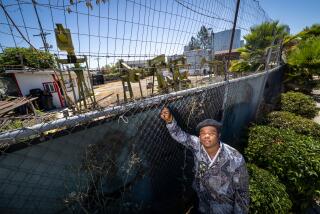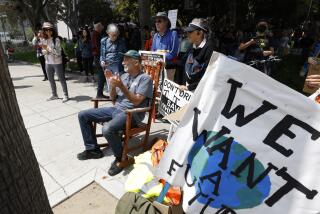Globalization Activists Go to Charm School
WASHINGTON — In a church basement a couple of miles from the citadels of international finance, opponents of globalization are trying to revive the spirit of Seattle.
An anti-globalization garage band unleashes a sonic barrage titled “Third World Scene.” The Anti-Authoritarian Babysitters Club offers to keep an eye on infants of the revolution. Forty or so protest planners stand shoulder to shoulder in a circle and chant “Si, se puede” over and over.
Translation: Yes, it can be done. Even after Sept. 11.
Nearly three years after 50,000 protesters virtually shut down a meeting of global trade officials in Seattle, activists would be pleased to mobilize a mere 10,000 when the International Monetary Fund and the World Bank hold their fall meetings in Washington this weekend. In the aftermath of last year’s terrorist attacks, which made any form of civil disobedience seem unpatriotic, even that goal may be optimistic.
But there’s more to a movement than street theater and crowd counts. Authorities on development issues, including some of globalization’s stalwart defenders, say the movement in this country has broadened, matured and become more influential in the 33 months since Seattle.
“The movement is getting much more sophisticated, even the activists in the streets,” said Nancy Birdsall, a former World Bank official who heads the Center for Global Development in Washington. “It’s gone from anti-globalization to alternative globalization to managing globalization.”
Development experts credit activist pressure at least in part for a range of developments, including a decision by the World Bank to give poor countries a bigger voice in developing poverty-reduction plans and agreement by the World Trade Organization to give top priority to the needs of poor countries in the round of worldwide trade talks launched last year.
Globalization critics denounce some of those initiatives as inadequate. But if nothing else, they represent an acknowledgment that wealthy nations and their financial institutions cannot afford to appear indifferent to global injustice.
“They won the verbal and policy battle,” said Gary Hufbauer, a pro-globalization economist at the Institute for International Economics in Washington. “They did shift policy. Are they happy that they shifted it enough? No, they’re not ever going to be totally happy, because they’re always pushing.”
Experts see evidence of the movement’s growing influence in other arenas.
Several high-profile economists, including Nobel Prize winner Joseph Stiglitz, have endorsed some of the specific criticisms and objectives of the movement. Their critique was reinforced by growing evidence of the failure of “Washington consensus” formulas to foster growth in Africa, Asia and Latin America.
The issue of Third World debt relief resonated with a much wider audience when Treasury Secretary Paul H. O’Neill and Irish rock star Bono jointly toured some of sub-Saharan Africa’s poorest countries.
Many development experts point to Jubilee 2000, the Third World debt-relief group whose work has been championed by Bono, as the non-government organization with perhaps the most influence over public policymaking.
“Jubilee 2000 had a tremendous impact in mobilizing focus and political support for the decisions that were eventually made,” said Mats Karlsson, the World Bank’s vice president for external affairs. The result, he said, “is a very radical debt relief program that is now being implemented country by country.”
Other groups have had an effect too. Oxfam, the London-based relief organization, made waves with a report stating that more trade liberalization, if managed properly, is the best prescription for reducing world poverty. The International Labor Organization has convened a high-profile working group to assess the social implications of globalization.
“All of the major organizations have grown enormously more powerful and effective. The only thing that’s shrunk is the street protests,” said Mark Weisbrot, co-director of the liberal Center for Economic and Policy Research in Washington. “The movement hasn’t lost momentum at all. It just shifted to a different set of tactics.”
For every organization involved in what some call the “movement of movements,” there have also been smaller but symbolically important victories.
Jubilee USA’s crusade has been joined by a remarkably wide range of organizations, from conservative evangelical churches to the San Francisco 49ers football team.
For the World Bank Bond Boycott, which hopes to generate the kind of financial pressure that helped end apartheid, a big turning point was the Milwaukee City Council’s 13-1 vote this spring to join the campaign. “We’ve seen a huge shift,” said boycott coordinator Neil Watkins. “When we started in 2000, there’s no way we could have even talked to the city of Milwaukee.”
Leaders say the movement’s evolving profile reflects a deliberate decision to tone down the increasingly provocative street mobilizations staged outside meetings of the IMF, World Bank, World Trade Organization and other global institutions.
Although authorities said the vast majority of participants were peaceful, small groups of Black Bloc anarchists and other extremists were giving the protests a violent edge. In Seattle, their antics contributed to $2 million in property damage and 500 arrests.
Then came Sept. 11. Public revulsion for terrorism and heightened concern about security created even more ambivalence within the movement about the merits of street mobilizations.
Anti-globalization groups had been planning a Seattle-size protest at the fall 2001 meetings of the IMF and World Bank in Washington, but the sessions were canceled shortly after Sept. 11. When the institutions held their spring meetings here in April, only 1,000 or so protesters rallied outside their headquarters.
“After 9/11, the U.S. movement obviously reevaluated its tactics and its tone,” said Lori Wallach, who has directed Public Citizen’s Global Trade Watch operation since 1990. “But even before 9/11, there was a strategy judgment that we needed to diversify the ways in which we organized and mobilized.”
Wallach said the movement’s current level of energy and engagement far exceeds what prevailed during the struggle over ratification of the North American Free Trade Agreement.
“At the time, you could have put 15 people on a bus--activists, labor leaders, members of Congress--and if that bus went over a cliff, it would have been the end of the NAFTA campaign,” she said.
Today, a whole fleet of plummeting buses wouldn’t slow the movement much.
Although the ranks of street protesters have thinned, they may be more diverse. Jubilee USA, which declined to participate in past mobilizations because of concerns about potential violence, will be part of the action this weekend.
National coordinator Marie Clarke said Jubilee decided to join the crowd because organizers made a stronger commitment to nonviolence, and because the AIDS epidemic and endemic poverty were rapidly worsening in the Third World.
“As fast as we’ve been working and as successful as we’ve been so far, I feel like we’re really running out of time,” Clarke said. “When the long-term advocacy people working in the system finally have to go to the streets, it tells you there’s an urgency there.”
David Levy, one of the protest coordinators stationed in the basement bunker of St. Stephen’s Episcopal Church, scoffs at suggestions that the movement has lost its edge.
“In social movements, there’s kind of a good-cop, bad-cop phenomenon,” said Levy, who works with the umbrella group Mobilization for Global Justice. “We go out in the streets and confront the evils of these institutions with very hard rhetoric. There are others who say, ‘Negotiate with us,’ and get a seat at the table.
“They wouldn’t get that seat without the pressure from the street.”
More to Read
Sign up for Essential California
The most important California stories and recommendations in your inbox every morning.
You may occasionally receive promotional content from the Los Angeles Times.










